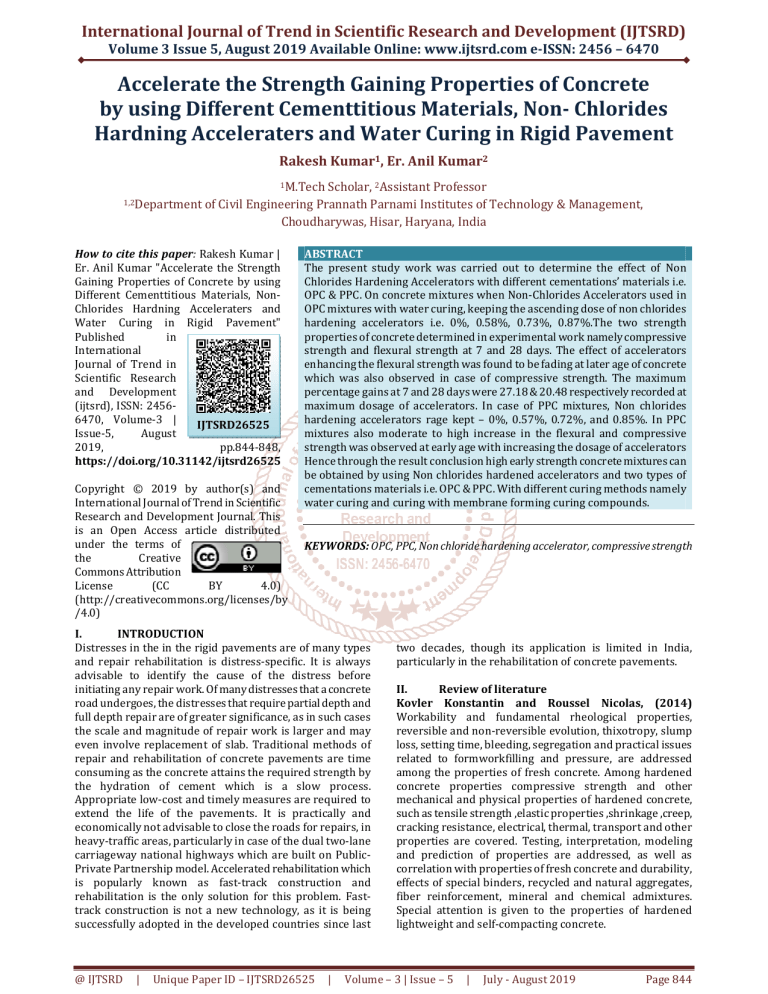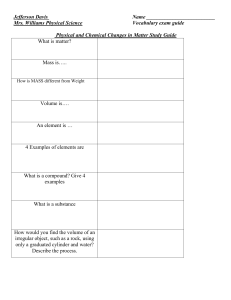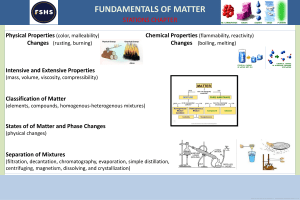
International Journal of Trend in Scientific Research and Development (IJTSRD)
Volume 3 Issue 5, August 2019 Available Online: www.ijtsrd.com e-ISSN: 2456 – 6470
Accelerate the Strength Gaining Properties of Concrete
by using Different Cementtitious Materials, Non- Chlorides
Hardning Acceleraters and Water Curing in Rigid Pavement
Rakesh Kumar1, Er. Anil Kumar2
1M.Tech
Scholar, 2Assistant Professor
1,2Department of Civil Engineering Prannath Parnami Institutes of Technology & Management,
Choudharywas, Hisar, Haryana, India
How to cite this paper: Rakesh Kumar |
Er. Anil Kumar "Accelerate the Strength
Gaining Properties of Concrete by using
Different Cementtitious Materials, NonChlorides Hardning Acceleraters and
Water Curing in Rigid Pavement"
Published
in
International
Journal of Trend in
Scientific Research
and Development
(ijtsrd), ISSN: 24566470, Volume-3 |
IJTSRD26525
Issue-5,
August
2019,
pp.844-848,
https://doi.org/10.31142/ijtsrd26525
Copyright © 2019 by author(s) and
International Journal of Trend in Scientific
Research and Development Journal. This
is an Open Access article distributed
under the terms of
the
Creative
Commons Attribution
License
(CC
BY
4.0)
(http://creativecommons.org/licenses/by
/4.0)
ABSTRACT
The present study work was carried out to determine the effect of Non
Chlorides Hardening Accelerators with different cementations’ materials i.e.
OPC & PPC. On concrete mixtures when Non-Chlorides Accelerators used in
OPC mixtures with water curing, keeping the ascending dose of non chlorides
hardening accelerators i.e. 0%, 0.58%, 0.73%, 0.87%.The two strength
properties of concrete determined in experimental work namely compressive
strength and flexural strength at 7 and 28 days. The effect of accelerators
enhancing the flexural strength was found to be fading at later age of concrete
which was also observed in case of compressive strength. The maximum
percentage gains at 7 and 28 days were 27.18 & 20.48 respectively recorded at
maximum dosage of accelerators. In case of PPC mixtures, Non chlorides
hardening accelerators rage kept – 0%, 0.57%, 0.72%, and 0.85%. In PPC
mixtures also moderate to high increase in the flexural and compressive
strength was observed at early age with increasing the dosage of accelerators
Hence through the result conclusion high early strength concrete mixtures can
be obtained by using Non chlorides hardened accelerators and two types of
cementations materials i.e. OPC & PPC. With different curing methods namely
water curing and curing with membrane forming curing compounds.
KEYWORDS: OPC, PPC, Non chloride hardening accelerator, compressive strength
I.
INTRODUCTION
Distresses in the in the rigid pavements are of many types
and repair rehabilitation is distress-specific. It is always
advisable to identify the cause of the distress before
initiating any repair work. Of many distresses that a concrete
road undergoes, the distresses that require partial depth and
full depth repair are of greater significance, as in such cases
the scale and magnitude of repair work is larger and may
even involve replacement of slab. Traditional methods of
repair and rehabilitation of concrete pavements are time
consuming as the concrete attains the required strength by
the hydration of cement which is a slow process.
Appropriate low-cost and timely measures are required to
extend the life of the pavements. It is practically and
economically not advisable to close the roads for repairs, in
heavy-traffic areas, particularly in case of the dual two-lane
carriageway national highways which are built on PublicPrivate Partnership model. Accelerated rehabilitation which
is popularly known as fast-track construction and
rehabilitation is the only solution for this problem. Fasttrack construction is not a new technology, as it is being
successfully adopted in the developed countries since last
@ IJTSRD
|
Unique Paper ID – IJTSRD26525
|
two decades, though its application is limited in India,
particularly in the rehabilitation of concrete pavements.
II.
Review of literature
Kovler Konstantin and Roussel Nicolas, (2014)
Workability and fundamental rheological properties,
reversible and non-reversible evolution, thixotropy, slump
loss, setting time, bleeding, segregation and practical issues
related to formworkfilling and pressure, are addressed
among the properties of fresh concrete. Among hardened
concrete properties compressive strength and other
mechanical and physical properties of hardened concrete,
such as tensile strength ,elastic properties ,shrinkage ,creep,
cracking resistance, electrical, thermal, transport and other
properties are covered. Testing, interpretation, modeling
and prediction of properties are addressed, as well as
correlation with properties of fresh concrete and durability,
effects of special binders, recycled and natural aggregates,
fiber reinforcement, mineral and chemical admixtures.
Special attention is given to the properties of hardened
lightweight and self-compacting concrete.
Volume – 3 | Issue – 5
|
July - August 2019
Page 844
International Journal of Trend in Scientific Research and Development (IJTSRD) @ www.ijtsrd.com eISSN: 2456-6470
Ghafoori N. and Tays M. W.,(2010) The selected fast-track
Type I Portland cement concretes were studied for
resistance to wear at both opening and maturity (28 days)
times.Depth of wear and rate of deterioration as functions of
matrix proportions and constituents, opening-time
categories, and testing duration were determined. The
influence of variables such as cement content, curing age,
and accelerating admixture on compressive strength and
abrasion resistance of the selected matrices were studied.
The coefficient of variation and abrasion index for the
abrasion test of the trials concrete were also examined.
Lastly,the relationship between the abrasion resistance
(depth of wear) and compressive strength at both opening
and maturity ages were investigated.
Gupta Vedprakash (2009) This report examines the repair
and restoration of concrete pavements systematically by
distress classification and the underlining objectives of each
concrete repair and restoration technique. It also covers the
composition and characteristics of a broad range of repair
materials for cracks, spalling, potholes, rough patches and
sunken slab. The review covers techniques used in routine
maintenance of concrete pavements but excludes slab
replacement. Emphasis will be given to road pavements but
they are also applicable to other concrete pavements.
TEST RESULT
III.
FRESH CONCRETE
All the mixtures were tested by Slump test, to assess the
workability. Tables give the workability values of OPC and
PPC mixtures for various dosages of accelerator.
Table -Workability of OPC mixtures
Mixture
OPC0 OPC1 OPC2
Accelerator Dosage (%)
0
0.58
0.73
Slump (mm)
10
10
10
OPC3
0.87
5
Table Workability of PPC mixtures
Mixture
PPC0 PPC1 PPC2
Accelerator dosage (%)
0
0.57
0.72
Slump (mm)
10
10
10
Mix
OPC0
OPC1
OPC2
OPC3
Mix
OPC0
@ IJTSRD
|
PPC3
0.85
10
HARDENED CONCRETE – STRENGTH
The results and discussions on the hardened properties of
the concrete mixtures at early age and at full maturity are
reported in this section. Compressive and flexural strengths
of the mixtures cured with water and alternatively with
curing compound, for various dosages of accelerator and at
different curing ages are presented. Percentage gains in
compressive and flexural strengths of all the mixtures (OPC,
PPC ) cured with water and alternatively with curing
compound, for different accelerator dosages and at different
curing ages, measured with reference to that of respective
control mixtures were assessed, so as to investigate the
influence of accelerator on the hardened properties at early
and later age of concrete mixtures. Average efficiency of the
curing compound for the compressive and flexural strengths
of all the mixtures at different curing ages was also assessed.
The efficiency of the curing compound for a given mixture, at
a given period of curing and for a known dosage of
accelerator was defined as the ratio of strength of the
mixture cured with curing compound to the strength of the
same mixture cured with water, expressed as percentage.
Average efficiency of the curing compound at a given curing
age was calculated as the average of the efficiencies at the
corresponding age for different dosages of accelerator. The
ratio of the flexural and compressive strengths is always part
of discussions in the experimental reports on concrete,
particularly on pavement concrete. The flexural strength
results are affected by moisture conditions and it is
practically proven that variability of the modulus of rupture
is higher.
OPC Mixtures
This section reports the results and discussions on the
compressive and flexural strengths of OPC mixtures at early
age and at full maturity.
Compressive strength of water-cured OPC mixtures
Compressive strengths of OPC mixtures cured with water for
various dosages of accelerator and at different curing ages
are reported in tables.
Table Compressive strength of water-cured OPC mixtures at 7 days
Specimen Id Accelerator, % Failure load, kN Comp. strength, Mpa Average Value, MPa
OPCW01
0
833.85
37.06
OPCW02
0
824.07
36.62
37.20
OPCW03
0
853.47
37.93
OPCW11
0.58
860.83
38.26
OPCW12
0.58
863.28
38.37
38.19
OPCW13
0.58
853.47
37.93
OPCW21
0.73
863.28
38.37
OPCW22
0.73
853.47
37.94
38.37
OPCW23
0.73
873.09
38.80
OPCW31
0.87
887.80
39.46
OPCW32
0.87
882.90
39.24
39.16
OPCW33
0.87
873.09
38.80
Table Compressive strength of water-cured OPC mixtures at 28 days
Specimen Id Accelerator, % Failure load, kN Comp. strength, Mpa Average value, MPa
OPCW01
0
1125.69
50.03
OPCW02
0
1118.34
49.70
49.96
OPCW03
0
1128.15
50.14
Unique Paper ID – IJTSRD26525
|
Volume – 3 | Issue – 5
|
July - August 2019
Page 845
International Journal of Trend in Scientific Research and Development (IJTSRD) @ www.ijtsrd.com eISSN: 2456-6470
OPC1
OPC2
OPC3
OPCW11
OPCW12
OPCW13
OPCW21
OPCW22
OPCW23
OPCW31
OPCW32
OPCW33
0.58
0.58
0.58
0.73
0.73
0.73
0.87
0.87
0.87
1128.15
1137.96
1140.41
1157.58
1167.39
1174.75
1177.20
1167.39
1184.56
50.14
50.58
50.68
51.45
51.88
52.21
52.32
51.89
52.65
50.46
51.85
52.29
Discussion
All the mixtures attained the stipulated design strength at 28 days of curing. Accelerator was moderately effective in increasing
the compressive strength of concrete mixtures at early age.. The accelerator had negligible effect at 28 days in all the mixtures,
which shows its waning effect in the later age of concrete.
Flexural strength of water-cured OPC mixtures
Flexural strengths (modules of rupture) of OPC mixtures cured with water for various accelerator dosages and at different
curing ages are shown in table
Mix
OPC0
OPC1
OPC2
OPC3
Mix
OPC0
OPC1
OPC2
OPC3
Specimen Id
OPCW01
OPCW02
OPCW03
OPCW11
OPCW12
OPCW13
OPCW21
OPCW22
OPCW23
OPCW31
OPCW32
OPCW33
Table Flexural strength of water-cured OPC mixtures at 7 days
Accelerator, % Failure load, kN Modulus of rupture, MPa
0
12.5
5.00
0
12.5
5.00
0
12.0
4.8
0.58
12.5
5.00
0.58
13.0
5.20
0.58
13.0
5.20
0.73
13.0
5.20
0.73
14.0
5.60
0.73
14.0
5.60
0.87
14.5
5.80
0.87
15.0
6.00
0.87
14.5
5.80
Specimen Id
OPCW01
OPCW02
OPCW03
OPCW11
OPCW12
OPCW13
OPCW21
OPCW22
OPCW23
OPCW31
OPCW32
OPCW33
Table Flexural strength of water-cured OPC mixtures at 28 days
Accelerator, % Failure load, kN Modulus of rupture, MPa
0
15.5
6.20
0
15.5
6.20
0
15.5
6.20
0.58
16.0
6.40
0.58
16.0
6.40
0.58
15.0
6.00
0.73
16.0
6.40
0.73
16.5
6.60
0.73
15.0
6.00
0.87
17.0
6.80
0.87
17.0
6.80
0.87
18.0
7.20
Average Value, MPa
4.93
5.13
5.47
5.87
Average value, MPa
6.20
6.27
6.33
6.93
All the beam specimens of water-cured OPC mixtures developed cracks in their pure bending zones while failing under flexure.
The response of the mixtures to the addition of accelerator in the development of higher flexural strength was better than that
seen in the development of compressive strength. The effect of accelerator in enhancing the flexural strength was found to be
fading at later age of concrete, which was also observed in the case of compressive strength. The maximum percentage gains at
7 and 28 days were 27.18 and 20.48 respectively, recorded at the maximum dosage of the accelerator.
PPC Mixtures
The results and discussions on the compressive and flexural strengths of PPC mixtures at early age and at full maturity are
reported in this section. Accelerator dosage though varied from 2 litres to 5 litres per cubic metre of concrete following the
guidelines of the manufacturer, the dosages in PPC mixtures when expressed in terms of percentage of cement mass slightly
differed from that in OPC mixtures due to variation in mix proportioning.
Compressive strength of water-cured PPC mixtures
The compressive strengths of the mixtures at different curing ages and for various dosages of accelerator, measured with
reference to that of the control mixture at the corresponding curing ages are shown in table.
@ IJTSRD
|
Unique Paper ID – IJTSRD26525
|
Volume – 3 | Issue – 5
|
July - August 2019
Page 846
International Journal of Trend in Scientific Research and Development (IJTSRD) @ www.ijtsrd.com eISSN: 2456-6470
Table Compressive strength of water-cured PPC mixtures at 7 days
Specimen Id Accelerator, % Failure load, kN Comp. strength, Mpa Average value, MPa
PPCW01
0
755.37
33.57
PPCW02
0
755.37
33.57
33.57
PPCW03
0
755.37
33.57
PPCW11
0.57
774.99
34.44
PPCW12
0.57
765.18
34.08
34.46
PPCW13
0.57
784.80
34.88
PPCW21
0.72
784.80
34.88
PPCW22
0.72
794.61
35.32
35.28
PPCW23
0.72
801.97
35.64
PPCW31
0.85
814.23
36.19
PPCW32
0.85
804.42
35.75
36.12
PPCW33
0.85
819.13
36.41
Mix
PPC0
PPC1
PPC2
PPC3
Mix
PPC0
PPC1
PPC2
PPC3
Table Compressive strength of water-cured PPC mixtures at 28 days
Specimen Id Accelerator, % Failure load, kN Comp. strength, Mpa Average value, MPa
PPCW01
0
1088.91
48.39
PPCW02
0
1098.72
48.83
48.65
PPCW03
0
1096.27
48.72
PPCW11
0.57
1098.72
48.83
PPCW12
0.57
1096.27
48.72
48.65
PPCW13
0.57
1088.91
48.39
PPCW21
0.72
1108.53
49.26
PPCW22
0.72
1108.53
49.26
49.29
PPCW23
0.72
1110.98
49.37
PPCW31
0.85
1147.77
51.01
PPCW32
0.85
1147.77
51.01
51.01
PPCW33
0.85
1147.77
51.01
Discussion
Performance of accelerator at early age in PPC mixtures cured with curing compound was observed to be moderate but was
inferior to its performance in the same mixtures when cured with water. The compressive strength of all the mixtures cured
with curing compound for a given curing age and for a given dosage of accelerator was found to be lesser than that of the
mixtures cured with water. None of the mixtures could attain the stipulated design strength at 28 days of curing.
Flexural strength of water-cured PPC mixtures
The flexural strengths for different accelerator dosages and for different curing ages, measured with reference to that of control
mixture at the corresponding curing ages are shown in table.
Mix
PPC0
PPC1
PPC2
PPC3
Mix
PPC0
PPC1
@ IJTSRD
|
Specimen Id
PPCW01
PPCW02
PPCW03
PPCW11
PPCW12
PPCW13
PPCW21
PPCW22
PPCW23
PPCW31
PPCW32
PPCW33
Table Flexural strength of water-cured PPC mixtures at 7 days
Accelerator, % Failure load, kN Modulus of rupture, MPa
0
13.00
5.20
0
12.00
4.80
0
11.00
4.40
0.57
12.00
4.80
0.57
13.00
5.20
0.57
12.00
4.80
0.72
12.50
5.00
0.72
12.00
4.80
0.72
14.00
5.60
0.85
13.00
5.20
0.85
13.00
5.20
0.85
13.00
5.20
Specimen Id
PPCW01
PPCW02
PPCW03
PPCW11
PPCW12
PPCW13
Table Flexural strength of water-cured PPC mixtures at 28 days
Accelerator, % Failure load, kN Modulus of rupture, MPa
0
17.00
6.80
0
16.00
6.40
0
16.50
6.60
0.57
17.00
6.80
0.57
17.00
6.80
0.57
16.00
6.40
Unique Paper ID – IJTSRD26525
|
Volume – 3 | Issue – 5
|
Average Value, MPa
4.80
4.93
5.13
5.20
Average Value, MPa
July - August 2019
6.60
6.67
Page 847
International Journal of Trend in Scientific Research and Development (IJTSRD) @ www.ijtsrd.com eISSN: 2456-6470
PPCW21
PPCW22
PPCW23
PPCW31
PPCW32
PPCW33
PPC2
PPC3
0.72
0.72
0.72
0.85
0.85
0.85
17.00
15.00
18.00
15.00
18.00
18.00
Discussion
Pure flexure failure was observed in all the beam specimens
of water-cured PPC mixtures. Moderate to high increase in
the flexural strength was observed at early age with increase
in the dosage of accelerator. The response of the accelerator
was found to be poor at 7 and 28 days in increasing the
flexural strength. The maximum flexural strength at a given
curing age was mostly observed when the accelerator dosage
was maximum.
IV.
Conclusion
1. Workability of all the mixtures (OPC, PPC) was found to
be low. Mixtures were insensitive to slump test. Increase
in accelerator dosage resulted in further reduction in the
workability,. Workability of the PPC mixture for a given
dosage of accelerator was lower than that of OPC
mixture.
2. Accelerator was effective at early age of concrete
mixtures. Strength of the mixtures at full maturity was
the least affected due to the addition of accelerator. All
the water-cured mixtures attained stipulated design
strength at 28 days.
3. The compressive strength response of the water-cured
OPC mixtures to accelerator was moderate
4. There was excellent compressive strength response of
water-cured PPC mixtures to accelerator
5. The optimum performance of accelerator was high and
was consistent in case of flexural strength
V.
[1]
REFERENCES
Kovler Konstantin and Roussel Nicolas, “Properties of
Fresh and Hardened Concrete”, Cement and Concrete
Research, Vol. 41, No. 7, 2014, pp 775-792.
@ IJTSRD
|
Unique Paper ID – IJTSRD26525
|
6.80
6.00
7.20
6.00
7.20
7.20
6.67
6.80
[2]
Ghafoori N. and Tays M. W., “Resistance to Wear of
Fast-track Portland Cement Concrete”, Construction
and Building, Vol. 24, No. 8, 2010, pp 1424-1431.
[3]
Gupta VedPrakash, “Repair and Improvement of
Damaged Cement Concrete Pavement”, Indian
Highways, Vol. 37, No. 9, 2009, pp 47-50.
[4]
Dao Vinh T. N., Dux Peter F. and Morris Peter H.,
“Tensile Properties of Early-Age Concrete”, ACI
Materials Journal, Vol. 106, No. 6, 2009, pp 483-492.
[5]
Kapila K. K., “Case Study of Cracking of a Newly Built
Road”, Indian Highways, Vol. 37, No. 6, 2009, pp 71-74.
[6]
Bissonnette Benoit, Attiogbe Emmanuel K.,
Miltenberger Matthew A. and Fortin Carl, “Drying
Shrinkage, Curling, and Joint Opening of Slabs-onGround”, ACI Materials Journal, Vol. 104, No. 3, 2007,
pp 259-267.
[7]
Sikdar P. K., “Pavement Preservation-A Better
Understanding”, Indian Highways, Vol. 34, No. 11,
2006, pp 47-50.
[8]
Lee H., Cody R. D., Cody A. M. and Spry P. G., “The
Formation and Role of Ettringite in Iowa Highway
Concrete Deterioration”, Cement and Concrete
Research, Vol. 35, No. 2, 2005, pp 332-343.
[9]
Collepardi M., “A State-of-the-art Review on Delayed
Ettringite Attack on Concrete”, Cement & Concrete
Composites, Vol. 25, No. 4-5, 2003, pp 401-407.
[10] Bouzoubaa Nabil, Fournier Benoit, Malhotra V. Mohan
and Golden Dean M.,“Mechanical Properties and
Durability of Concrete Made with High-Volume Fly Ash
Blended Cement Produced in Cement Plant”, ACI
Materials Journal, Vol. 99, No. 6, 2002, pp 560-567.
Volume – 3 | Issue – 5
|
July - August 2019
Page 848



